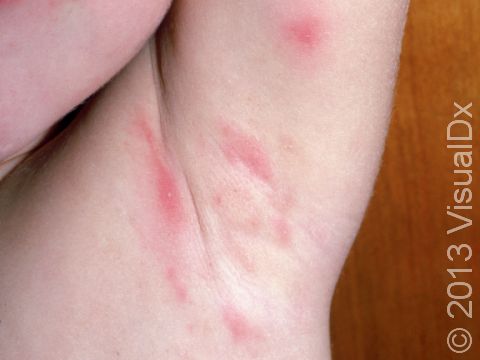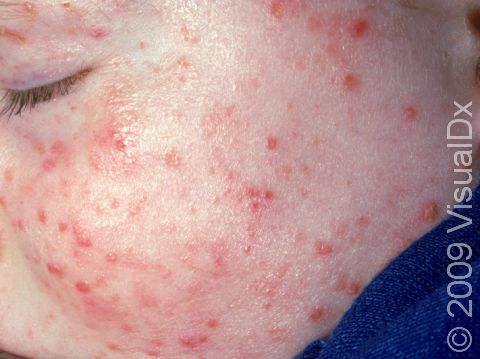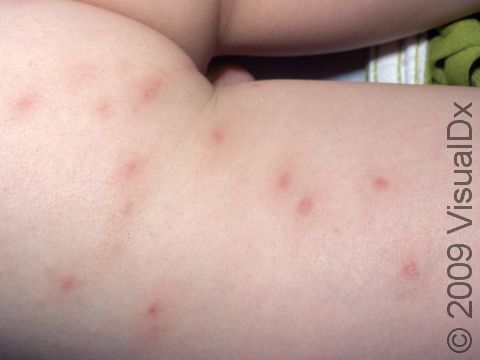Folliculitis
Folliculitis refers to an infection of the hair follicles. Folliculitis is most common on the parts of the body that experience friction, such as the face, scalp, back, and thighs. The friction caused by clothing, sweat, and oils on the skin can block and irritate the follicles, allowing bacteria that normally reside on the skin, such as Staphylococcus (or “staph”), to get into these follicles and cause the infection.
Who's At Risk?
In infants, the following increase the likelihood of folliculitis:
- Wearing tight clothes
- Using antibiotics or steroids for long periods of time
- A weakened immune system
- Having an infected cut, scrape, or surgical incision
Signs & Symptoms
The most common locations for folliculitis in children include the:
- Scalp.
- Face.
- Buttocks.
- Arms and legs.
Individual lesions of folliculitis include pustules (pus-filled bumps) and papules (small solid bumps) centered on hair follicles. These pustules and papules may be pierced by an ingrown hair, can vary in size from 2-5 mm, and are often surrounded by a ring of inflamed skin. In lighter skin colors, the lesions may be any shade of pink or red. In darker skin colors, the redness may be harder to see, and the bumps may be the only sign of the folliculitis. Occasionally, a folliculitis lesion can break open, drain, and form a scab on the surface of the skin.
Mild and moderate folliculitis is often tender or itchy. More severe folliculitis, which may be deeper and may affect the entire hair follicle, can be painful.
Mild and moderate folliculitis usually go away quickly with treatment and leave no scars. However, more severe folliculitis may lead to more serious complications such as an infection of the deeper skin tissue (called cellulitis), scarring, and permanent hair loss in the affected area.
Self-Care Guidelines
To prevent folliculitis, you should avoid dressing your baby in clothing that is tight, especially if they get sweaty.
To attempt to clear up mild folliculitis, you can try the following:
- Bathe your baby with a gentle baby wash or shampoo if the scalp is involved (eg, Johnson’s Head-To-Toe Wash and Shampoo).
- Wash their towels, washcloths, and bed linens often.
Treatments
Folliculitis is usually fairly easy to diagnose by examining the baby’s skin.
Your baby’s medical professional may recommend:
- Prescription-strength antibacterial wash, such as hexachlorophene.
- Topical antibiotic cream or ointment, such mupirocin.
Visit Urgency
See your baby’s pediatrician or another medical professional for any pustular condition, as pustules may be seen in conditions other than folliculitis.
Tell your baby’s medical professional about any recent exposure to swimming pools or other public water areas because a less common form of folliculitis may be caused by bacteria living in these water sources.
If your baby is currently being treated for a skin infection that has not improved after 2-3 days of treatment, return to their medical professional.
References
Bolognia J, Schaffer JV, Cerroni L. Dermatology. 4th ed. Philadelphia, PA: Elsevier; 2018.
James WD, Elston D, Treat JR, Rosenbach MA. Andrew’s Diseases of the Skin. 13th ed. Philadelphia, PA: Elsevier; 2019.
Kang S, Amagai M, Bruckner AL, et al. Fitzpatrick’s Dermatology. 9th ed. New York, NY: McGraw-Hill Education; 2019.
Paller A, Mancini A. Paller and Mancini: Hurwitz Clinical Pediatric Dermatology. 6th ed. St. Louis, MO: Elsevier; 2022.
Last modified on June 14th, 2024 at 9:14 am

Not sure what to look for?
Try our new Rash and Skin Condition Finder



